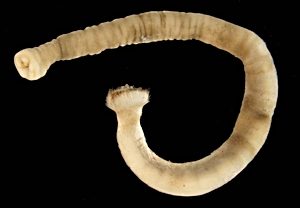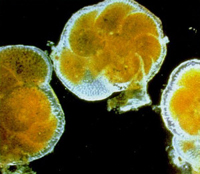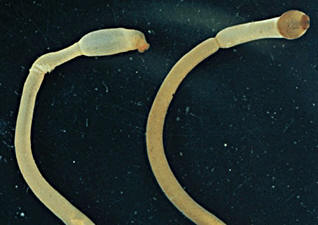Caudofoveata
Synonym: Chaetodermomorpha.
| Class |
Species No. |
| Snails (Gastropoda) |
43.000 |
| Mussels (Bivalvia) |
10.000 |
| Squids (Cephalopoda) |
650 |
| Elephant Tusks (Scaphopoda) |
600 |
| Neopilina (Tryblidia) |
20 |
| Chitons (Placophora) |
750 |
| Solenogastres |
230 |
| Caudofoveata |
120 |
|
|
| Molluscs (Mollusca) |
55.400 |
Species number of molluscs.
 Diagram.
Diagram. |
|
|
The exclusively sea-living class Caudofoveata is among the least
known molluscs. Only by the end of the 19th century it became known
that they are molluscs; before they had been placed among the
holothurians, worm like echinoderms, related to starfish. So were the
solenogasters (Solenogastres).
| |

Chaetoderma intermedium, a caudofoveatan.
Picture: Nina Mikkelsen,
Bergen University. |
Caudofoveatans generally are very small, mostly only few centimetres
long. They live in a depth of more than 20 m, where they can appear in
a density of up to 4 to 5 individuals per square metre, as far down to the deep sea.
Externally, caudofoveatans resemble worm-like beings. They have no
recognizable shell, which is why they are counted among the so-called
shell-less molluscs ("Aplacophora"). With a closer look,
some characters typical for molluscs can be recognized. Though
caudofoveatans do not have a shell, they do have a sturdy exterior
tissue, the cuticula. This cuticula is additionally protected by
calcareous scales, which are estimated to be a predecessor of the more
highly developed molluscs' shell. Chitons (Polyplacophora)
also have this cuticula, but only as a rudimentary protection around
their sides, the so-called girdle or perinotum. The rest of the
molluscs' back is protected by shell plates, that are thought to have
evolved from calcareous scales we find today among caudofoveatans.
It
is well imaginable that the first molluscs have evolved from worm-like
ancestors, such as the caudofoveatans, which lived on the ocean floor
or dug in it, and whose sturdy skin was protected by calcareous scales,
which in time would change into the astounding shell of most of today's
mollusc groups. The worm-like form of today's caudofoveatans, though,
is the result of a secondary reduction of the foot, more advanced in
this group, than, for example, in the solenogasters.
 The evolution of the mollusc shell.
The evolution of the mollusc shell.
| |

Foraminifers, the main food of
scaphopods and caudofoveatans. |
At their head end, caudofoveatans have a hard shield studded with
sense cells helping the creature's orientation. Caudofoveatans live on
the ocean floor, where they look for food, either crawling or digging.
On the one hand they are detritus eaters, so they live on decaying
organic matter, or they feed on monocellular organisms, such as
foraminifers and diatoms (silicate algae).
As in all molluscs,
also in caudofoveatans, feeding takes place with the help of a rasp
tongue, the radula, which may have as many as 1,000 toothlets.
Caudofoveatans, though, do not yet possess the ribbon-like radula of
higher molluscs; theirs grows from the oesophagus wall. So the radula
is a very old character, which seems to have appeared with the very
first molluscs long ago. Among caudofoveatans, the radula is quite
variable, comparable to the radula of a gastropod. In that regard,
caudofoveatans are different from scaphopods, similar in their digging
way of life, and chitons (Polyplacophora).
As
do other molluscs, caudofoveatans also have a pallial cavity, only it
is very small and located at the body's end. In the pallial cavity,
there are the paired comb-gills or ctenidia. The gonad, the sexual
organ, is located on the dorsal side and from it a efferent duct leads
to the pericardium (the heart bag) and from there several ducts open into
the pallial cavity, also a very ancient character. The dorsal gonad is
also present in chitons (Polyplacophora), so it is a character which
both groups have in common. Caudofoveatans have separate sexes, so
there are males and females, fertilisation takes place externally in
the water. As it does among the solenogasters, larval development in
caudofoveatans takes place passing a planktontic trochophora stage.
The
neural system of the Caudofoveata is simple and built like a rope
ladder. There is, though, a recognizable cerebral ganglion to provide
the cerebral shield with neurons.
Further Information:
Literature:
Salvini-Plawen, L.; Mizzaro-Wimmer, M.: "Praktische
Malakologie - Beiträge zur vergleichend anatomischen
Bearbeitung der Mollusken", Vienna 2001.


